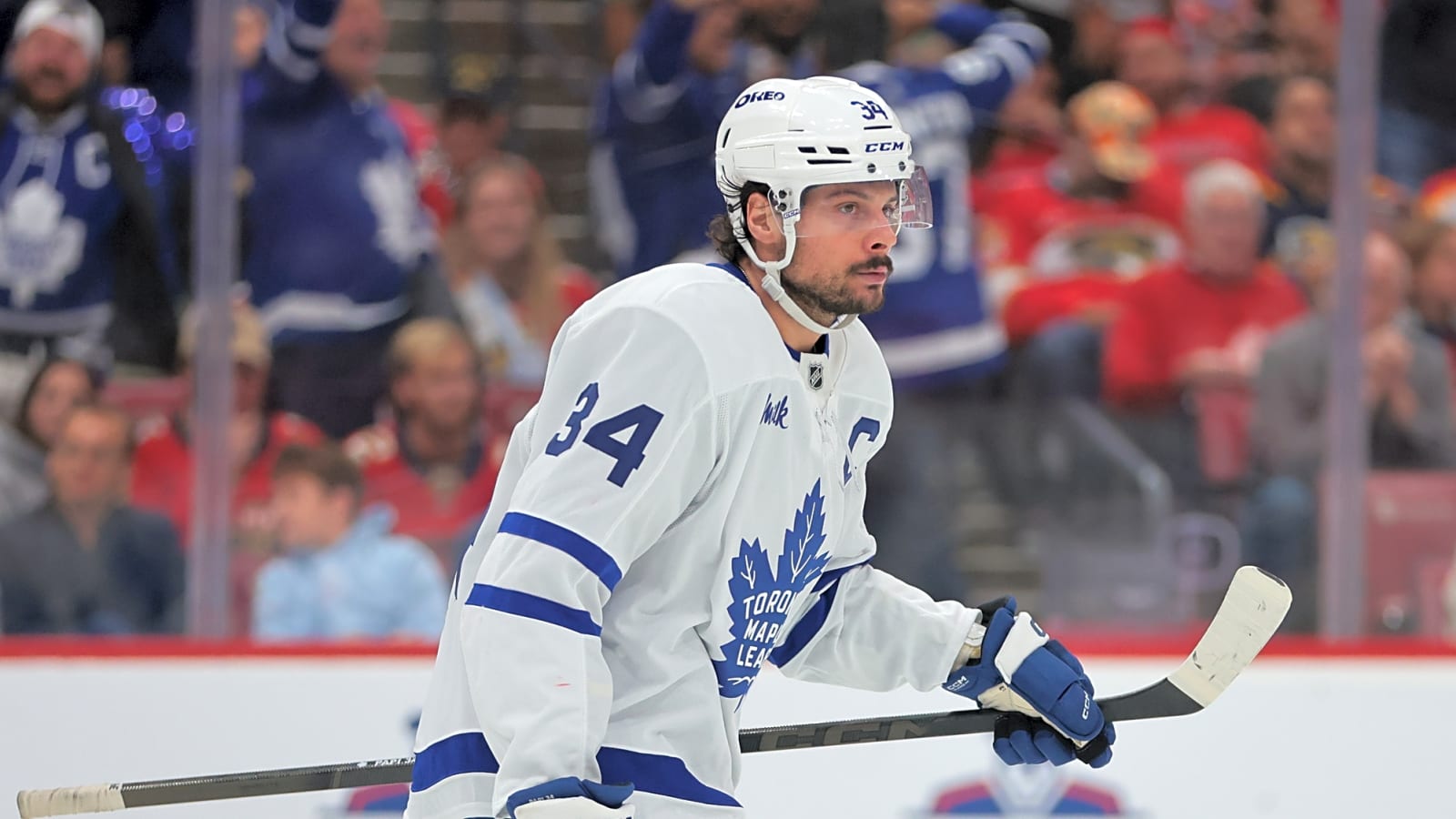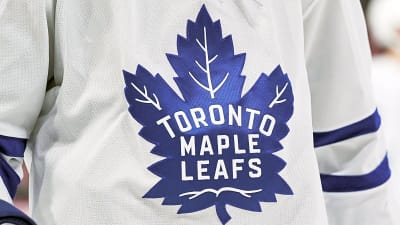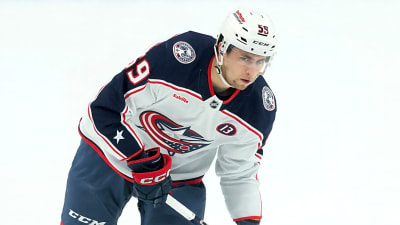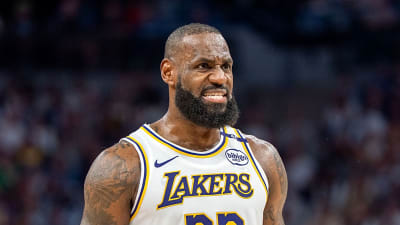
With the upcoming 2025–26 season on the horizon, many Leafs fans are curious about how the team will improve from last season. There are numerous ways in which a team can improve from season to season, including new additions and internal development. Another way to improve is through better performances from the players on the team. Let’s take a look at some Leafs who might be able to author a bounce-back season in 2025–26.
Matthews
The most obvious candidate for positive regression is Leafs captain Auston Matthews. After a stunning 69-goal season in 2023–24, Matthews potted only 33 goals last year. Obviously, missing the talents of Mitch Marner is not necessarily ideal, but the truth is that Matthews should be able to outscore his 33-goal 2024–25 regardless of linemates. The main reason would be health, as Matthews was clearly limited at several points last season.
The Leafs will have some playmakers to pair with Matthews. Max Domi and Matias Maccelli seemed destined to battle for a cushy spot on Matthews’ wing. Of course, William Nylander remains an option as well, with Easton Cowan earning a look here seems overly ambitious. Whichever playmaking winger is able to fill the role will be in line for a strong shot at a career season. Either way, Matthew Knies is slated to roll alongside, providing a good power game for Matthews and a skilled playmaker to feed off of.
Back to accolades
Matthews should be in the conversation for the Rocket Richard Trophy, and could take the opportunity to reassert himself as a Hart Trophy candidate as well. With John Tavares expected to take on more offensive usage, Matthews will need to provide a lot of defensive aptitude for the Leafs as well. A return to Selke Trophy consideration for Matthews would be huge for the Leafs, as his case for the Hart Trophy lies in the fact that he can legitimately and simultaneously contend for the Selke and Richard Trophies.
Though Matthews will need to author some bigger moments in the playoffs, he is still the centrepiece for the Leafs. Fans of rebuilding teams can only hope that their star centres can reach Matthews’ level, and his return to his best gives the Leafs a leg up on a competitive Atlantic Division.
Rielly
Morgan Rielly is much less likely to have a bounce-back season, but it remains a distinct possibility. For years now, corners of Leaf Nation have started to sour on Rielly, yet Rielly has continued to elevate his game in key moments. As the Leafs’ blueline has become bigger and more defensive under GM Brad Treliving, Rielly’s offensive presence has also become more vital.
Oliver Ekman-Larsson provides some help in this area, but it would be entirely irresponsible for the Leafs to deal Rielly without a contingency plan at this point. Rielly’s trade protection only makes matters more difficult as the concept itself becomes less likely. Perhaps a trade of Rielly for Erik Karlsson, for example, would make sense for the Leafs, but beyond deals of that ilk, the concept is not very pragmatic. As much as trading Rielly might make sense in a vacuum, it makes less sense given the context of the team.
Looking ahead
The best-case scenario is that the Leafs can get more out of Rielly, even if only to improve his trade value down the road. Rielly will continue to be a key piece of the Leafs’ blueline. Perhaps yet another look on the top power play is in order with Marner gone. Perhaps more time in coach Craig Berube’s system, and the offseason to train for it, will be the answer. There is even hope in the fact that he might build more chemistry with expected defence partner Brandon Carlo.
Either way, Rielly is no longer a fringe option for a best-on-best Team Canada. There are clearly better defencemen, and better values, around the league. Fans looking for such comparisons seek only folly, as the Leafs require a skill set like Rielly’s more than ever. His flow of play metrics might not be pretty, nor his visible defensive lapses, but that should not distort the values and strengths that Rielly does provide. Rielly should have a few good seasons left, and there are definitely paths for him to improve on his work from last season.
Maccelli
Although he was not on the team last season, Matias Maccelli is in line for a bounce-back. Entering this past season, Maccelli was seen as an up-and-coming middle-six forward, a playmaker who could handle defensive usage. Spending much of his first two seasons on a line with Jack McBain and Lawson Crouse, Maccelli complemented these bigger linemates well.
It all fell apart for Maccelli as the team moved to Utah, as his production decreased to the point where he was out of the regular lineup altogether. Maccelli clearly has the tools and the talent to be an effective player, and the Leafs have a need for forwards who can contribute in the top-nine. With the departure of Marner, Maccelli’s playmaking abilities will be of greater importance for the Leafs.
Obviously, if Maccelli is able to find his way onto a line with Matthews and Knies, it would give him the chance to shatter his career highs. The same might be said if Maccelli can earn a spot alongside Nylander and Tavares, though that trio seems to lack the size that coach Craig Berube seems to prioritize on each line. In the end, Maccelli might do best on a line with Nic Roy and Bobby McMann, essentially recreating the lines that made him so successful as a member of the Arizona Coyotes.
A spot on the second power play unit would help as well, as Maccelli needs opportunities to use his playmaking talents to be at his most confident. With one year left on his deal, this season represents a huge inflection point for Maccelli’s NHL career. If he is able to return to form, he might find himself a staple of the Leafs’ forward group for years to come.
Laughton
After changing teams for the first time in his NHL career, Scott Laughton seemed to have a difficult time finding his footing as a Leaf. The high price of his acquisition, which included some retained salary, set expectations for his impact high. Especially given that his role on the Leafs will be smaller than it was with the Philadelphia Flyers, Laughton will have a difficult time replicating his career highs in production.
A centre known for a willingness to do the dirty work, a bounce back for Laughton has more to do with identity than it does production. A successful season will involve a lot of defensive work and intensity, perhaps giving the bottom of the Leafs’ lineup definition. Laughton is unlikely to play with skilled linemates, but he will have to be effective in physical battles should he ever get the chance. Most of his offence will have to be found closer to the net or the inner slot.
While a penalty killing role would help, Laughton will need to be a big part of establishing an identity line for the Leafs. This likely will be a forechecking line that has enough defensive awareness to handle their own zone, as well as enough skill to advance the puck up ice. The absolute ceiling for Laughton would be as a worker bee alongside more skilled linemates, an opportunity that should elude him next season. Perhaps he might be a fit on a checking line, even as a winger, when forced up the lineup.
Jarnkrok
Entering the last season of his deal, it appears that Calle Jarnkrok has almost completely fallen out of favour. While the versatile forward brings a well-rounded game, his lack of definition has many fans wondering how and where he can contribute. A big piece of the puzzle is his lack of playoff production, though missing most of the past season with injury did him no favours in being remembered.
A healthier Jarnkrok should be able to put together a much more impactful season ahead. His speed and willingness to embrace a depth role could make him a staple of the bottom-six. While his offensive game is limited, his shot might well be an asset among the Leafs’ more defensively inclined forwards. At the very least, Jarnkrok can be depended on for responsible defensive play.
A trade asset
The issue is that Jarnkrok’s contract makes him a candidate to balance salary in a trade. For much of the offseason, fans have been shipping out more expensive bottom-six forwards like Jarnkrok or David Kampf to make room for more ambitious additions. With the rising cap, talent has become more valuable than cap space. The Leafs might be able to make something work, but at this point, their trade assets are more of a hurdle than their amount of cap space.
If Jarnkrok does remain a Leaf, he will undoubtedly have a bigger impact than last season. Under former coach Sheldon Keefe, Jarnkrok earned a lot of trust and, at times, was seen as a stabilizing force for any line that he was deployed with. He might help his case by earning a special-teams role, more likely as a penalty killer. In all, forming some chemistry could be key, as he has played well on a line with Tavares in the past. Jarnkrok could be an asset on the forecheck, and centres like Nic Roy or Scott Laughton might welcome his speed.
More must-reads:
- Numerous games stand out among NHL's newly released 2025-26 schedule
- A Buddhist monk is surprisingly in contention at the Open Championship
- The 'MLB Home Run Derby champions' quiz
Breaking News
Trending News
Customize Your Newsletter
 +
+
Get the latest news and rumors, customized to your favorite sports and teams. Emailed daily. Always free!








